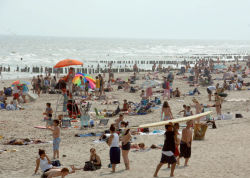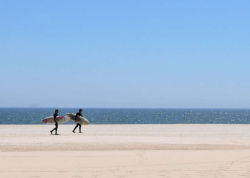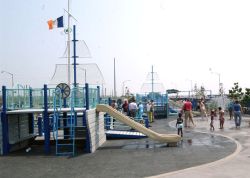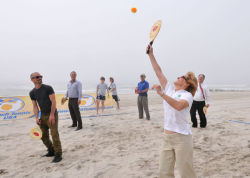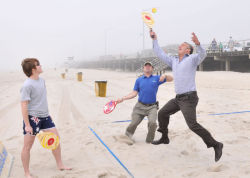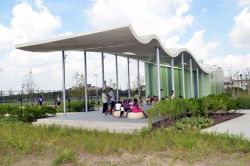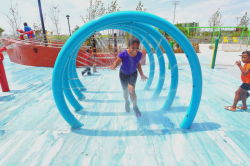Rockaway Beach and Boardwalk
Army Corps Awards $26.4 Million Second Sand Pumping Contract For Post-Sandy Rockaway Beach Restoration As First Contract Sand Starts Pumping
Thursday, August 15, 2013
No.
http://www.nyc.gov/parks
Sand pumping began earlier this week and is part of first of two contracts
Second contract awarded Wednesday for ~3M cubic yards of sand
Total sand pumped through both contracts will be ~3.5M cubic yards of sand
Work on both contracts expected to be completed in early 2014
Second contract awarded Wednesday for ~3M cubic yards of sand
Total sand pumped through both contracts will be ~3.5M cubic yards of sand
Work on both contracts expected to be completed in early 2014
NEW YORK – Representatives from the U.S. Army Corps of Engineers, New York District, New York
City , New York state and community partners came together to announce both the beginning of sand
pumping on Rockaway Beach and the award of a $26.4 million contract for the placement of even more
sand to aid post-Sandy restoration efforts.
Overall, the Corps is placing roughly 3.5 million cubic yards of sand along Rockaway Beach from
Beach 19th to Beach 149th to replace sand lost during Hurricane Sandy. This work will restore the
beach to its design profile—making it better than it was before Sandy’s impact. The work is being done
through two contracts totaling $36.4 million.
The $26.4 million contract was awarded to Weeks Marine of Cranford, N.J., yesterday and is the
second and larger of two sand placement contracts for Rockaway Beach. It is for the placement of
roughly 3 million cubic yards of sand from Beach 19th Street to Beach 149th Street. The sand for this
second contract will be dredged from an offshore borrow area.
The first of the two sand placement contracts for Rockaway was awarded earlier this summer and sand
placement work on that contract is ongoing. It was a $10 million contract, also awarded to Weeks
Marine. That contract was for the placement of roughly up to 600,000 cubic yards of sand being
dredged from East Rockaway Inlet. Sand is being placed from Beach 89th to Beach 149th as part of
the first contract.
The second, larger contract will include the placement of additional sand in areas where sand was
placed through the first contract. When both contracts are complete, the beach will have been restored
to its original design from when the Corps first constructed the beach in the 1970s in partnership with
New York state and New York City. The originally constructed beach included at least a 100 foot wide
beach berm that was 10 feet above sea level.
The beach restoration work at Rockaway is being done as part of near-term coastal restoration efforts
taking place at previously constructed coastal storm risk reduction projects throughout the region. While
the beach at Rockaway provides recreational benefits, it is primarily designed to act as a buffer to help
reduce the impacts from coastal storms.
“The Army Corps of Engineers is excited to begin restoration work on Rockaway Beach," said New
York District Commander Col. Paul E. Owen. “We’re proud to be working closely with our partners in
the city and state of New York to help the Rockaway community as they continue to recover from the
impacts of Sandy. This sand pumping work will help improve the area’s coastal storm risk reduction,
while also improving recreation and restoring the beach which is an important part of Rockaway’s
identity.”
The beach restoration work at Rockaway is being carried out to provide additional coastal storm risk
reduction for the community using the Corps of Engineers statutory authorities to repair the federally
constructed project at Rockaway that was constructed in the 1970s in partnership with the state of New
York and New York City.
"New York City’s beaches are much more than places for fun in the sun – they’re also a critical defense
against flooding and coastal storms," said New York City Mayor Michael Bloomberg. "We’re hard at
work strengthening those defenses – including here with Phase 2 of our restoration work in Rockaway
Beach. Working with the Army Corps of Engineers, we are taking measures to not only reverse damage
to the beach done by Sandy – but make the beach stronger than it was before the storm. That means
communities on the Rockaway peninsula will be better protected from future storms and flooding."
The Corps is working closely with its partners in the New York State Department of Environmental
Conservation and the New York City Department of Parks and Recreation as it carries out these beach
restoration efforts at Rockaway Beach.
"New York City's beaches are not only a summer vacation for millions of people, they are a backyard
for local residents and our first line of defense against future storms and flooding," said NYC Parks
Commissioner Veronica M. White. "Thanks to the Army Corps of Engineers, more than 3.5 million
cubic yards of sand are being added to Rockaway Beach resulting in a beach that will be higher, wider,
and more protective than it has been in decades.”
Everything the U.S. Army Corps of Engineers does must be tied to a statutory authority and this work at
Rockaway Beach is the result of two statutory authorities, one previously existing and one new since
Hurricane Sandy.
Through the Flood Control and Coastal Emergencies Act, PL 84-99, the Corps of Engineers is
authorized to repair previously constructed projects after a large event like Hurricane Sandy. Put
simply, this pre-existing authority allows the Corps to return the project area to pre-storm conditions.
Through this legal authority, the Corps of Engineers is authorized to place approximately 1.5 million
cubic yards of sand along Rockaway Beach to replace the roughly 1.5 million cubic yards of sand lost
from the project area during Hurricane Sandy.
Through the Disaster Relief Appropriations Act of 2013 (the Sandy Relief Bill, or PL 113-2), the Corps
of Engineers is authorized to restore certain previously constructed projects impacted by Hurricane
Sandy to their original design profile. Through this legal authority, the Corps of Engineers is authorized
to place the additional roughly 2 million cubic yards of sand at Rockaway Beach to restore the project
area to its original design profile. PL 113-2 also allocated the funds for the coastal restoration work.
While restoration work is going on, there will be rolling closures of roughly 1000 foot wide sections of
the beach where construction work is active, but the Corps of Engineers will make efforts to limit the
impacts of the ongoing work on recreation without compromising public safety. Closures will be closely
coordinated with the New York City Department of Parks and Recreation.
The coastal restoration work at Rockaway Beach is part of a larger U.S. Army Corps of Engineers effort
throughout the northeastern United States to place nearly 27 million cubic yards of sand to restore
coastal storm risk reduction projects impacted by Hurricane Sandy. Nearly 8 million cubic yards of that
will be placed at coastal storm risk reduction projects in the state of New York, including at Coney
Island and at project sites along the south shore of Long Island.
Check out your park's Vital Signs
Clean & Safe
$104.8M
Recent Investment
Green & Resilient
307
Mapped Trees
341.2
Acres of Natural Areas
Empowered & Engaged Users
Share your feedback or learn more about how this park is part of a
Vital Park System

